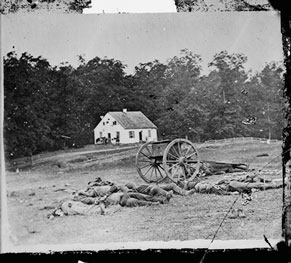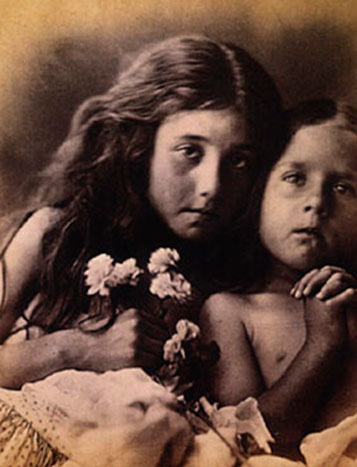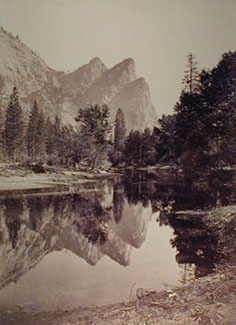
Photograph of Dunker Church at Antietam shot by Alexander Gardner
Invented by Frederick Scott Archer, an English engraver and sculptor, a process whereby a plate is coated with sensitized collodion and exposed to light while in a moist state. This decreased the exposure time dramatically (1 sec – 5 min), but required a portable darkroom for sensitizing plates on location.

Sensitized a grainless substance, collodion. Plate used in a moist state and exposed to light. Exposure time decreased dramatically (1 sec – 5 min). Needed portable darkroom for sensitizing plates.
Considered improvement over calotype. Better detail and sharpness.
Forced landscape photographers to transport an entire darkroom – tent, trays, scales, chemicals, and even distilled water – besides cameras and glass plates.
Glass negative yielded predictable results in less time. Together with the albumen print, retained sharpness because printing paper was coated with an emulsion.
Problems with limited responsiveness to certain light. Burnt out highlights or lack of shadow detail. Extreme contrast between dark and light areas. Challenges hurdled using masks and combining two negatives.
1845, First Panoramics were taken as embracing reality. Panoramic cameras used in an arc that rotated 120°. Resorted to replication through engraving, aquatints, and lithographs.
Julia Margaret Cameron

Julia Margaret Cameron
Julia Margaret Cameron used collodion process to portray family and associates in elaborately casual poses, domestic interiors and real gardens. Avoided sharp focus and evocatively handled light successfully creating allegorical and religious subjects.
Turned scenic landscape into an item of consumption. Photographed to create accurate archaeological records. Sought out best vantage point, but avoided expressive or dramatic effects of light and shadow. Promoted a style called “straight”. Photographic evidence was considered synonymous with truth.
In view of steadily encroaching urbanization, landscapes suggest a public nostalgia for virgin nature. Stereoviews were used to illustrate scientific and travel books. Led to The Stereoscopic Magazine.
Landscape photography developed in other countries in response to tourism as affluent British and German travelers searched for untamed nature. Others recognized value of westward expansion and found photography to be the ideal tool to enshrine ideas of “manifest destiny.”
Edweard Muybridge and Carleton Watkins

Carleton Watkins
Edweard Muybridge and Carleton Watkins produced views of Yosemite in 1868 and 1872. Enshrined the wilderness landscape as emblematic of the American dream of unsullied nature. Muybridge selected unusual viewpoints and disposition of figures in the landscape. Sometimes printed in clouds from separate negatives to satisfy critics.


